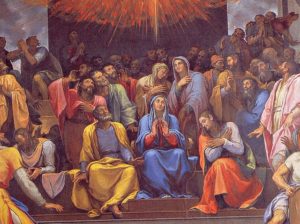Jun 04., 2022 / General, Homilies, Soul Food
The Upper Room
Homily on The Feast of Our Lady of the Cenacle | 4 June 2022
by Fr Oliver Dy, SJ
In Jerusalem of the time of Jesus, it was typical for the house owners in the city to own a second floor or an upper room to be rented out to pilgrims. It is in such a room that the Last Supper was held and many other occasions, the disciples celebrated in the Upper Room for the feasts in Jerusalem, thus, also the name Cenacle or dining room. It’s in this Upper Room that the election to replace Judas, the betrayer, was held. And it was also in such a room where “All these [the apostles] were constantly devoting themselves to prayer, together with certain women, including Mary, the mother of Jesus, as well as his brothers.”
The Upper Room. I would like to share my thoughts related to this Upper Room which for me symbolizes and mirrors the heart of Mary, Mary of the Cenacle. That there is a certain congruence of meaning of the Upper Room and the heart of Mary related to the three gifts of the Cenacle – Apostolic Service, Prayer and Community Life.
First of all, the Upper Room is a holy space between heaven and earth. It is grounded on the earth and yet also elevated above it to indicate a sense of perspective and spiritual transcendence. The Upper Room is grounded on the cry of the people who cry and with the groan of creation, so the vibrations of the earth, as it were, is felt in this Upper Room, and yet this Upper Room is also the meeting place between heaven and earth or rather the meeting place or the point of transition between the old heaven and old earth and a new heaven and a new earth. The Upper Room’s sense of apostolic service is that place where the old is transformed into the new. The Upper Room symbolizes the hill country of Judea where Mary visited Elizabeth in the sense that it is elevated and here, Mary’s Magnificat was heard for the first time, the revolution of the heart and the reversal of order in the world. And this perspective and this vision of Mary continues here in the upper room in a new way, in the apostolic service. There’s both a typical distance from the earth and yet also a certain typical intimacy. One should not succumb to the subtle temptations of the world but to live amidst them with a sense of perspective of Mary. And so, it is in the sense of spiritual deviation with the world that we can transform into a new heaven and a new earth just like Mary did in her time.
The second one is the Upper Room is the place of prayer. As it is located in this in-between space, the heaven and earth, it is the place of radical openness related to the virtue of hope and the act of waiting. The radical openness to God’s possibilities. Not so much to give in to the earthly projects in the act of presumptiveness or over-planning like the apostles did or thought when Jesus ascended, “Would He restore the kingdom of Israel?” It’s not that, rather, the radical openness to something totally new , totally unheard of. An openness by that which came forth from the heart of Mary from the womb, that Incarnate God himself, something unthought of before. This radical openness demands that we detach ourselves from our earthly project and have that clear space for prayer. The German word for this is “abgeschiedenheit” or “detachment” in English. The word is “gelassenheit” or “letting things be”. Not to give in, on the other hand, to utility and despair but to allow our pondering in prayer, the gradual pondering while waiting to allow the plan of God to unfold in His due time. So, we must maintain that radical openness in prayer like Mary in the Upper Room.
Finally, Mary and Community life. In the year 2018, Pope Francis also declared Monday after Pentecost as the Feast of Mary as Mother of the Church, and it is also related to the Feast of the Cenacle in this Upper Room where Mary became part of the emergent Church and in fact, became also a witness to the maturation of the disciples, the apostles in the Spirit. They were with one accord, a single heart. And this means spiritual conversation and fruits of prayer. I can imagine Mary sharing the stories about her Son to encourage the apostoltes. I can hear Mary entering into dialogue with the apostles in the spirit of the Lord’s absence. I can see Mary co-discerning in their fellow pilgrims here on earth. Mary was at the side of the apostles. She was with the apostles. She was companion to the apostles. She was telling the apostles, “You are not alone, I am here, your mother.” She died with the apostles and lived with the apostles at their side.
The word Paraclete incidentally is someone called to one’s side. I can imagine the Paraclete as somebody beside us. Somebody who strengthens us when we need strength. Someone who speaks for us like a lawyer. Paraclete symbolizes God by our side. In the same way, Mary in community life is a woman, a person by the side, beside the apostles, being with, being together with the apostles in the place of prayer, in the place of emerging apostolic service.
In this Mass today, let us pray for the spiritual blessings related to this Upper Room, that symbolizes and reflects the very heart of Mary, Mary in the Cenacle, apostolic service, in prayer and community life.










